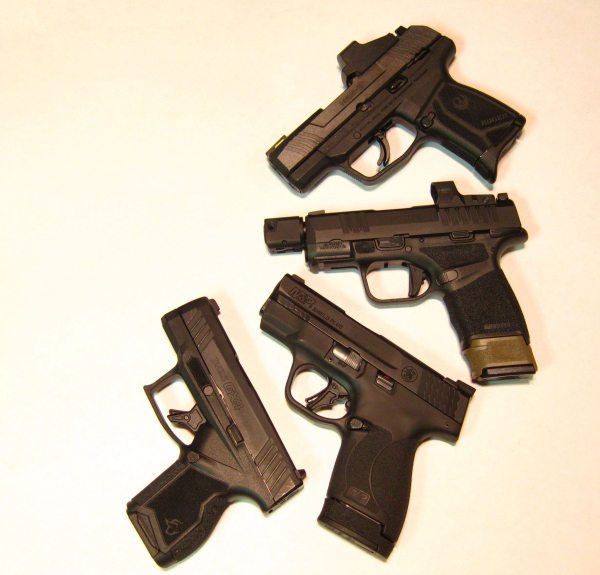
As I continue evaluating the “Class of 2021” – new guns built to fit the envelope beginning with the Kel-Tec P-11, later popularized by the SIG SAUER P365 – I’ve arrived at the Springfield Armory Hellcat RDP. The “Class of 2021” also included the Taurus GX4, the S&W Shield Plus and the Ruger MAX-9 (with optic), micro-9mm pistols with ‘maxi’ capacity.
In this case, I began with the “close-range benchmarks,” a hash of the Claude Werner-inspired “high-value” close range course, followed by Stage 2 of the FDLE (Florida Dept. of Law Enforcement) handgun qualification (as modified), then my understanding of the old Bakersfield PD/Mike Waidelich 10-shot qualification course. This would be followed by a short rendition of a typical police qual that is weighted a little more to distance.
For the close quarters piece, I used Remington Golden Saber 124gr brass-jacketed hollow-point ammo. I also wanted to evaluate the new 15-round Springfield Armory magazine for the Hellcat pistol line. This puts the micro-pistol into compact pistol magazine capacity territory – as well as gives the gun more length. While some will complain that it hampers concealment – true – it also increases shootability with the small gun. A point I’ll raise later about the new ammunition feeding device: … have a magazine loader.
From my feature on close-range benchmarks, I wanted to get the Springfield Armory Hellcat RDP on record as a way of comparing this gun to other members of the Class on the same course. Thinking one is cheating by close range shooting with an optics-enabled pistol, micro-compact as it is, is a mistake; the time constraints are tight. While I’m better at it than I was, I still have those “sundial” moments.
The Springfield Armory Hellcat RDP is quite the pistol. The HEX Wasp — a micro-sized red dot optic – seems to be all one needs for this size of pistol. It’s backed by the high visibility tritium plus luminescent front sight and Springfield Armory’s “Tactical Rack U-Dot” rear sight.
It’s a wonderful world when truly small pistols are furnished with really practical sights.
The Hellcat RDP comes with two magazines — a patented 11-round mag with pinky extension and a 13-round extended mag. After the announcement, I had to order the new 15-round mag.
The gun features a ‘Self Indexing Compensator’ made of aircraft-grade hardcoat anodized aluminum. It’s billed as a device which “vents gasses upward putting downward pressure on the muzzle greatly reducing muzzle rise …” I can tell you it works. Having shot other guns of this form factor, the comp is effective as advertised. I added the close-range ‘unsighted’ fire exercises primarily because the Hellcat RDP has a comp and I know people will ask about blast and debris hazards.
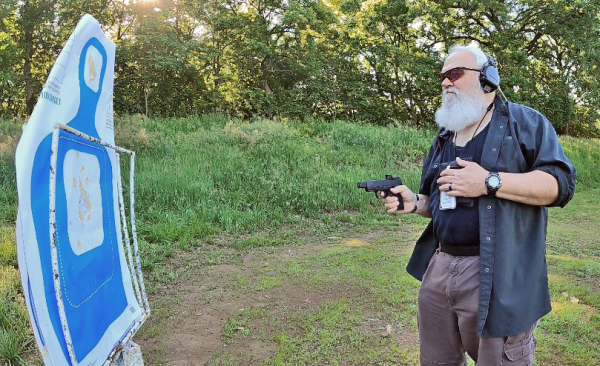
Thus far, I found no issues. I imagine there’s more perceived racket as well as blast effects without protective eye- and ear-wear, but I wasn’t going to try it that way. Along with Springfield Armory’s Gen 2 Trigger, with enhanced ergonomics of the trigger as well as the gun’s frame, the accuracy certainly seems to be there. Additionally, there’s a manual thumb safety with bilateral levers. Some “don’t like a safety” on their pistols, but I find it an additional prevention for a “bang!” when reholstering.
The safety is nicely placed and the levers well contoured to prevent accidental application of the safety when it’s not needed – and to prevent accidentally taking it off safe when you don’t want to.
The Rapid Defense Package is a nicely done rig.
The holster used for the test was the Galco TacSlide holster. A nice hybrid of a steerhide backer and a Kydex pouch; reminiscent of Roy Baker’s “Pancake” when combined with an open-bottom “Yaqui” slide type pouch. The almost-neutral cant makes for a locked wrist while establishing a grip while the gun’s holstered. The gun is pulled in close to the body and it makes the whole thing disappear under a light shirt.
The magazine pouch was the versatile Pitbull Tactical Universal Mag Carrier – Generation 2. It fits about every magazine for every test gun I’m trying – plus the single stack legacy Shield from S&W. That makes it perfect for these times when I’m trying out different guns without accumulating a lot of extra support gear.
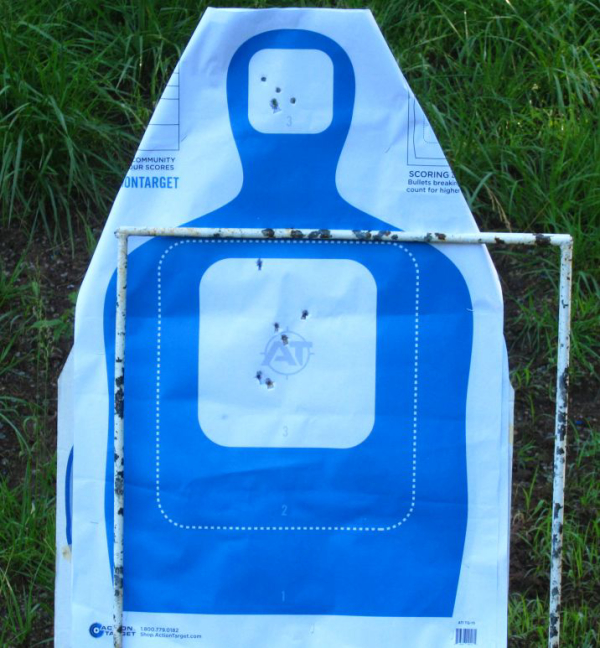
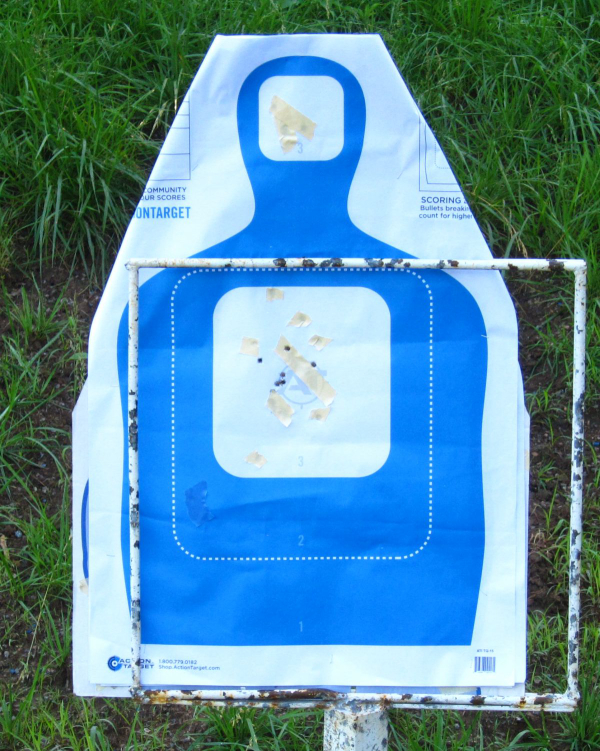
The way I do the close-range event is to start with the Claude Werner-inspired “high-value” close range course, five repetitions of a single shot to the “softball” in the “head” area of a silhouette from around 10 feet. The start is from the holster, with your hand on the gun as if being aware of potential problem without having drawn it yet. You have one second to deliver the high value shot.
I also “taxed” Stage 2 of the FDLE qualification but modified it. This event is at about 10 feet also, starting at a legitimate low-ready – muzzle aimed in on the ground below the target frame (avoiding a potential “aggravated assault” issue). At the signal, you put a “hammer” in the center of the target in one second or less. This is repeated twice for six rounds total.
Then it’s on to Mike Waidelich’s “Bakersfield (CA) PD” course: 10 rounds, from “never get closer than this (10-feet)” to “a car length” (from the old days, 20 feet), to “curb to front door” 30 feet, to 60 feet (“opposite curb to the front door”).
My “high-value” shots were from 1.06 second to .94 second. The Stage 2-FDLE repetitions went from .99 down to .80 second. I lost points due to time on the Waidelich standards without losing a point on the Action Target TQ-15 target until the one ‘trigger snatch’ at 20 yards put me down one. I ended up with 88/100 – right in the middle of the pack for the guns I’ve tried on the course so far. The Springfield Armory Hellcat RDP was first place in hits in the maximum scoring zone for the course. It won the ‘accuracy’ component.
After that, I loaded up and did a more traditional “qual standards” type of course. I started at 25 yards, a pair from the holster followed by two pairs from guard. All were in the maximum scoring zone.
Up close, I shot a single from ‘hip,’ followed by a pair. After that, from 7, 10 and 15 yards, I shot singles, pairs, one handed and some ‘failures to stop.’ This yielded 100%.

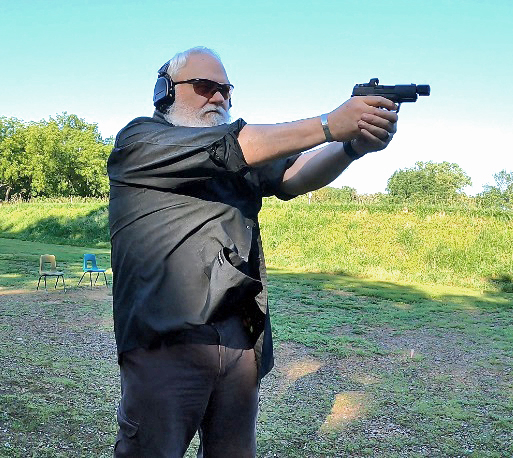
So, what about the 15-round magazine? Have a magazine loading device; based on our publisher’s warning, I had one available and it was still tough to get that magazine loaded. Also, seating the magazine with the slide forward is a chore.
It – like the 11- and 13 round magazines – worked 100%; fed, fired, locked the slide open, fell free.
It’s in the safe now, outside of the gun, loaded with fifteen rounds. There it’ll be for a few weeks, after which I’ll strip a round out. If I carry the Hellcat RDP, the big magazine will have fourteen rounds in it to facilitate an in-battery load.
All-in-all, the Springfield Armory Hellcat RDP is quite the concealed carry pistol. You don’t have to install the RDS, it has the compensator from the factory, it has standard-setting factory sights – which feature a lower co-witness through the HEX Wasp – and excellent ergonomics. I fear that I “cheated” this gun – as well as others – by using (what used to be) low cost steel-case ammo for some of the evaluation.
The Hellcat RDP didn’t notice. And it apparently likes high-quality premium ammo from Hornady, Federal and Remington as well as range ammo from Fiocchi.
If you’re in the market for a small gun that’s good in close as well as out to distance, the Hellcat RDP is a “must-see.”
-- Rich Grassi